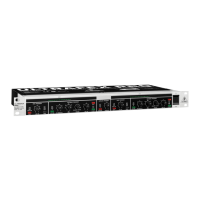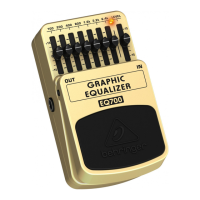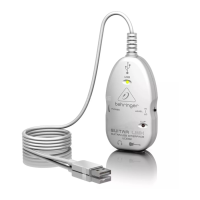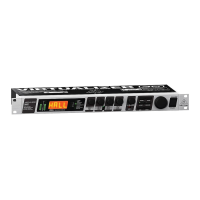14
ULTRAFEX PRO EX3200
s
The enrichment of the program material with artificially generated harmonics.
Independently of each other, each of these methods produces a certain effect which is perceived as a
subjective enhancement within the sound.
These methods are described in more detail in the following:
5.3.1 Frequency correction
The boosting or cutting of certain frequency ranges is the simplest form of sound modification. Equalizers can
correct the sonic image in order to produce a sound that is more pleasing to each taste.
So-called treble boosters achieve this effect by emphasizing the high frequencies, which the listener
perceives as a transparent sonic image.
Within the BEHRINGER ULTRAFEX PRO, any frequency correction is combined with a frequency-dependent
phase shift, which results in a sound that is warmer and more musical.
5.3.2 Phase shifting
The term phase shift describes the displacement of a signals phase in relation to its point of origin. As a matter
of principle, the phase shift produces a delay within the signal.
If the delayed signal is added to the original signal, the resultant signal becomes wider. Below time delay
values of 20 msec. the brain perceives the delayed arrival of the two signals as the arrival of one signal, which
results in the desired pulse enlargement effect, sometimes called 3-D effect by other manufacturers.
The effect produced by so-called chorus units is based on the same principle of phase shift and signal delay.
Here, several delayed signals are added to evenly intensify this effect.
The BEHRINGER ULTRAFEX PRO is equipped with a frequency-selective phase shift circuit that comprises
several stages. Due to the program-dependent delayed signal, the sonic impression becomes more vivid, as
with an orchestra, where the musical liveliness is the result of inaccurate entries by musicians.
5.3.3 Artificial harmonics generation
By 1955 an American, Charles D. Lindridge, had already invented the first EXCITER (a unit that EXCITES
upper harmonics), when he presented a unit for improving the sound of music and speech. He enriched signal
sources with artificially generated upper harmonics and found that both sound quality, transparency and
perceived positioning of musical instruments could be considerably improved using this effect. He was granted
an American patent on his circuit design under the number US 2 866 849.
Compared to modern technology, Lindridges circuit was anything but fully developed, however, it featured
many of the aspects found in todays modern circuit designs.
Psycho-acoustic discoveries and greater knowledge, gathered over the years, have allowed for new and
improved circuit designs, through the use of advanced technology.
5.4 The bass processor of the ULTRAFEX PRO
Apart from processing the upper harmonic ranges, users of the BEHRINGER ULTRAFEX PRO have access to
an innovative bass processor.
The numerous stages of processing during the recording, reproduction, copying and effecting processes,
increasingly delay the phase of the bass frequencies, when compared to the remaining frequency ranges. This
is why the low-frequency range suffers from a loss in power and fundamental bass definition.
With the help of frequency-selective phase shift combined with sub-bass boost, the bass processor of the
BEHRINGER ULTRAFEX PRO is capable of compensating for this loss, giving the program material new bass
presence. Using the MODE switch, you can select between two different bass sounds.
+ Be extremely careful when using the bass processor: excessive use of the bass processor
might lead to speaker damage. The amplified sub-bass frequencies may well place a heavy
load on the amplifier and the woofers. Therefore, carefully adjust the bass processor and
observe the power rating of your system!
5. TECHNICAL BACKGROUND

